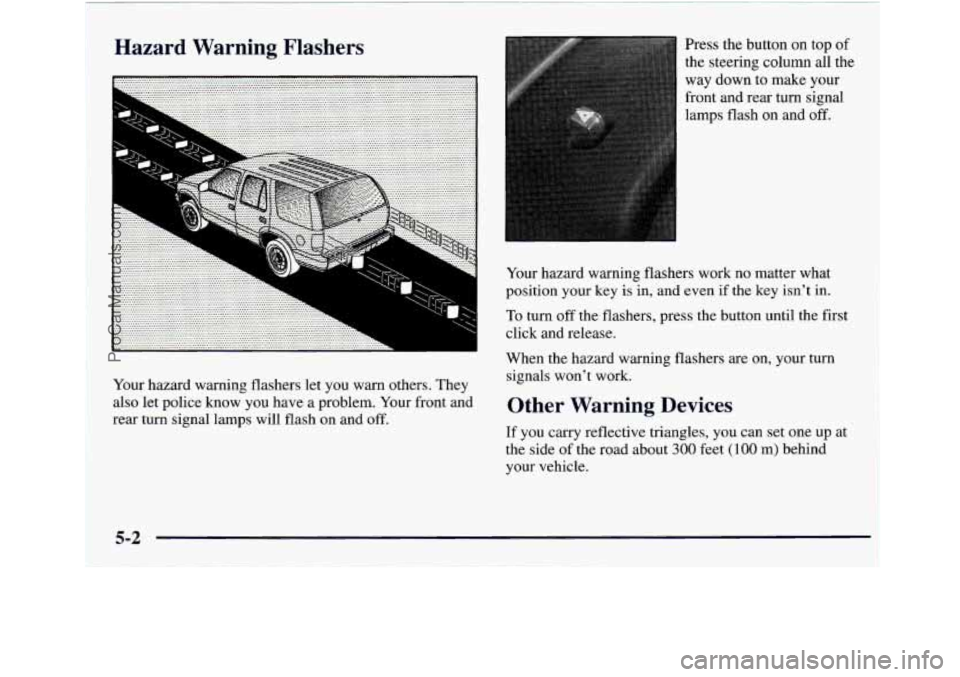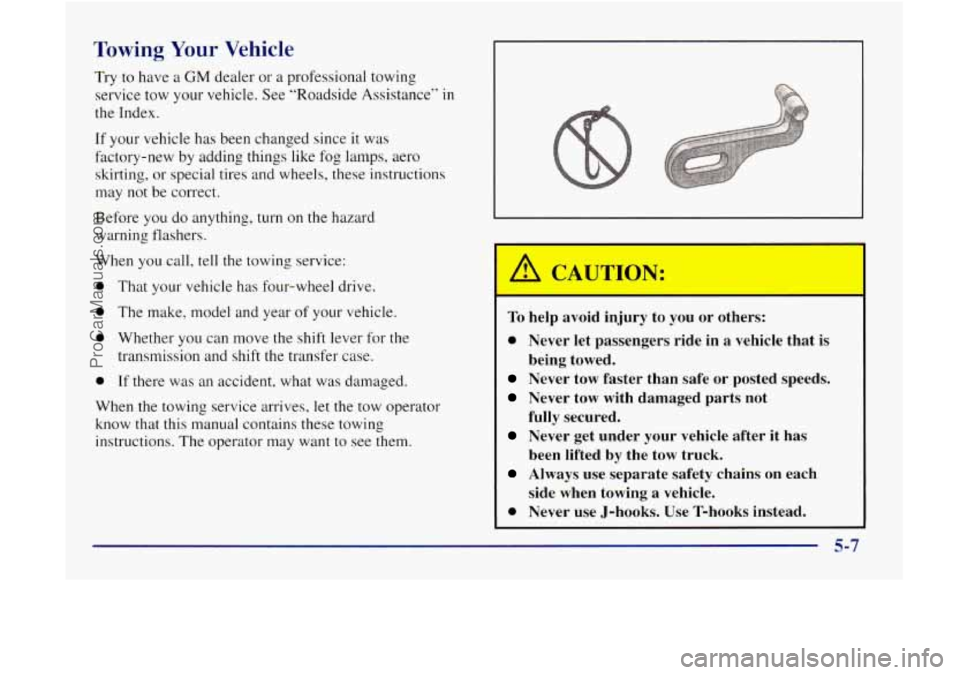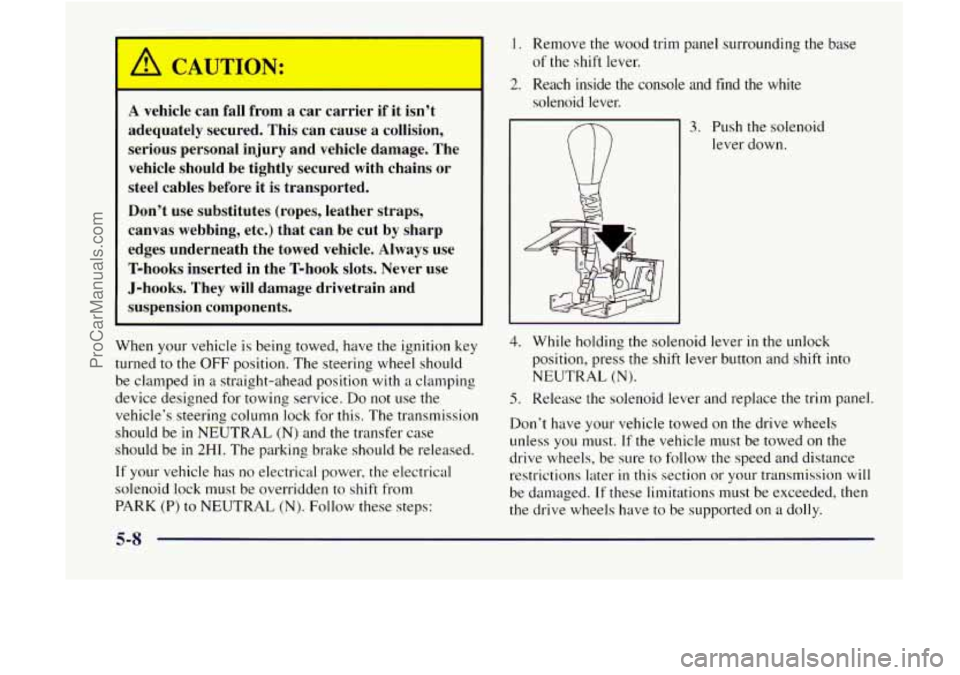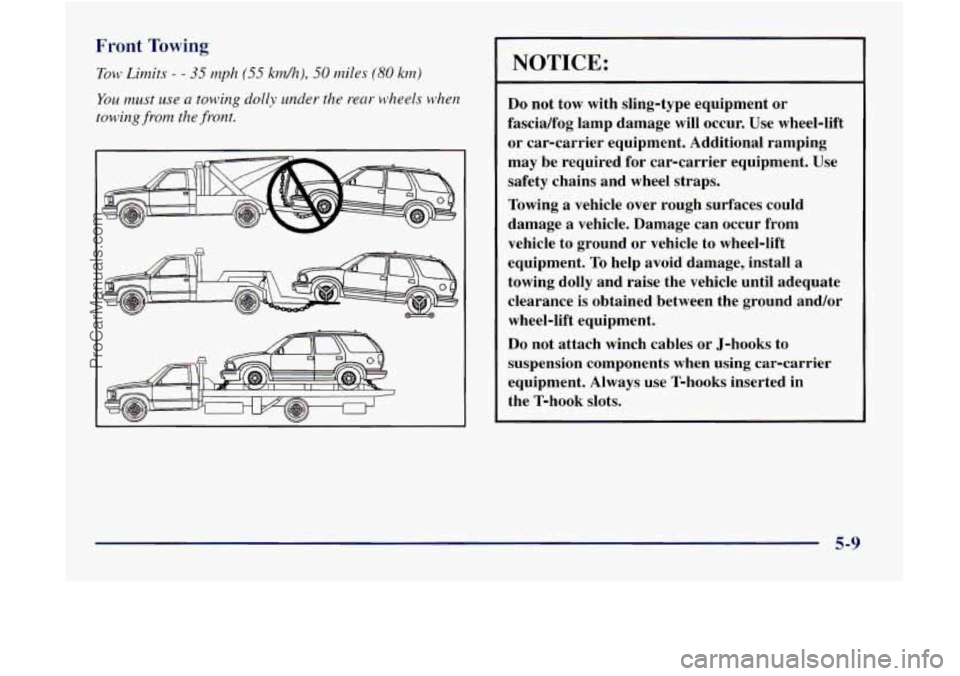GMC ENVOY 1998 Owners Manual
Manufacturer: GMC, Model Year: 1998, Model line: ENVOY, Model: GMC ENVOY 1998Pages: 386, PDF Size: 20.33 MB
Page 211 of 386

Trailer Wiring Harness
The heavy-duty trailer wiring is an eight-wire harness
assembly. The harness is stored under the vehicle, on the
driver’s side corner frame rear crossmember. The
heavy-duty trailer wiring has a 30-amp feed wire
with
an in-line fuse located by the junct.ion block. See “Fuses
and Circuit Breakers”
in the Index. The harness does not
have a cannector and should be wired by
a qualified
electrical technician. The technician can use the
following color code chart when connecting the wiring
harness
to your trailer.
0
0
0
0
0
0
0
0
Dark Blue: Use for electric trailer brakes or
auxiliary wiring.
Red: Use for battery charging;
it connects to the
starter solenoid.
Light Green: Back-up lamps.
Brown: Taillamps and parking lamps.
Yellow: Left stoplamp and turn signal.
Dark Green: Right stoplamp
and turn signal.
White (Heavy Gage): Ground wire.
White (Light Gage): Auxiliary stoplamp.
Securely attach the harness to the trailer, then tape or
strap
it to your vehicle’s frame rail. Be sure you leave it
loose enough so the wiring doesn’t bend or break, but
not
so loose that it drags on the ground. Store the
harness
in its original place. Wrap the harness together
and tie
it neatly so it won’t be damaged.
4-52
ProCarManuals.com
Page 212 of 386

Section 5 Problems on the Road
Here you’ll find what to do about some problems that can occur on the road.
5-2
5-2
5-3
5-7
5-11
Hazard Warning Flashers
Other Warning Devices
Jump Starting
Towing
Your Vehicle
Engine Overheating Engine
Fan Noise
If a Tire Goes Flat
Changing a Flat Tire
If You’re Stuck: In Sand, Mud,
Ice or Snow
5-20
5-20
5-2 1
5-32
ProCarManuals.com
Page 213 of 386

I’ :---d Warning Flashers
Your hazard warning flashers let you warn others. They
also let police know you have a problem. Your front and
rear turn signal lamps will flash
on and off. Press the button
on top of
the steering
column all the
way down to make your
front and rear turn signal
lamps flash on and
off.
Your hazard warning flashers work no matter what
position your key
is in, and even if the key isn’t in.
To turn
off the flashers, press the button until the first
click and release.
When the hazard warning flashers
are on, your turn
signals won’t work.
Other Warning Devices
If you carry reflective triangles, you can set one up at
the side of the road about
300 feet (100 m) behind
your vehicle.
5-2
ProCarManuals.com
Page 214 of 386

Jump Starting
If your battery has run down, you may want to use
another vehicle and some jumper cables to start your
vehicle.
But please use the following steps to do
it safely.
Batteries can hurt you. They c..-- be
dangerous because:
They contain acid that can burn you.
They contain gas that can explode or ignite.
They contain enough electricity to
If you don’t follow these steps exactly, some or all
burn
you.
’ of these things can hurt you.
NOTICE:
Ignoring these steps could result in costly damage
to your vehicle that wouldn’t be covered by
your warranty.
Trying to start your vehicle
by pushing or pulling
it won’t work, and it could damage
your vehicle.
1. Check the other vehicle. It must have a 12-volt
battery with a negative ground system.
NOTICE:
If the other system isn’t a 12-volt system with a
negative ground, both vehicles can be damaged.
5-3
I
ProCarManuals.com
Page 215 of 386

2. Get the vehicles close enough so the jumper cables
can reach, but be sure
the vehicles aren’t touching
each other.
If they are, it could cause a ground
connection you don’t want.
You wouldn’t be able to
start your vehicle, and the bad grounding could
damage
the electrical systems.
To avoid the possibility of the vehicles rolling, set
the parking brake firmly on each vehicle. Put your
vehicle
in PARK (P).
3. Turn off the ignition on both vehicles. Unplug
unnecessary accessories plugged into the cigarette
lighter or the accessory power outlets. Turn
off all
lamps that aren’t needed as well as radios. This will
avoid sparks and help save both batteries. In
addition, it could save your radio!
NOTICE:
If you leave your radio on, it could be badly
damaged. The repair wouldn’t be covered by
your warranty.
L
4. Open both hoods and locate the batteries. Find the
positive
(+) and negative (-) terminals on
each battery.
A
Using a match near a battery can cause battery
gas to explode. People have been hurt doing this,
and some have been blinded. Use
a flashlight if
you need more light.
Be sure the battery has enough water.
You don’t
need
to add water to the ACDelco Freedom’
battery installed in every new
GM vehicle. But if
a battery has filler caps, be sure the right amount
of fluid is there. If it is low, add water to take care
of that first. If you don’t, explosive gas could
be present.
Battery fluid contains acid that can burn you.
Don’t get it
on you. If you accidentally get it in
your eyes or on your skin, flush the place with
water and get medical help immediately.
5-4
ProCarManuals.com
Page 216 of 386

5. Check that the jumper cables don’t have loose or
missing insulation.
If they do. you could get a shock.
The vehicles could be damaged too.
Before
you connect the cables, here are some basic
things you should know. Positive
(+) will go to
positive
(+) and negative (-) will go to a metal
engine part. Don’t connect positive
(+) to
negative
(-) or you’ll get a short that would damage
the battery and maybe other parts too.
6. Connect the red
positive
(+) cable to the
positive
(+) terminal of
the vehicle with the
dead battery.
7. Don’t let the other end
touch metal. Connect
it
to the positive (+)
terminal of the
good battery.
8. Now connect the black
negative
(-) cable to
the good battery’s negative
(-) terminal.
Don’t let the other end
touch anything
until the
next step. The other end
of the negative cable
doesn’t go
to the dead
battery. It goes to
a heavy
unpainted metal
part on
the engine
of the vehicle
with the dead battery.
5-5
I
ProCarManuals.com
Page 217 of 386

9. Attach the cable at least
18 inches (45 cm) away
from the dead battery,
but not near engine parts
that move.
The electrical
1 connection is just as
good there, but the
chance
of sparks getting
back to the battery
is
much less.
10. Now start the vehicle with the good battery and run
the engine for awhile.
12. Remove the cables in reverse order to prevent
electrical shorting. Take care that they don’t touch
each other or any other metal.
1 1. Try to start the vehicle with the dead battery. If it
won’t start after a few tries, make sure all
connections are good. If it still won’t start, it
probably needs service.
A.
R
I A CAUL3N:
u.
I c-
Fans or other moving engine parts can injure you
badly. Keep your hands away from moving parts
once the engine
is running.
Heavy Metal Engine Part
Good Battery
Dead Battery
5-6
ProCarManuals.com
Page 218 of 386

Towing Your Vehicle
Try to have a GM dealer or a proressional towing
service tow your vehicle. See "Roadside Assistance"
in
the Index.
If your vehicle has been changed since it was
factory-new by adding things like fog lamps, aero
skirting, or special tires and wheels, these instructions
may not be correct.
Before you do anything, turn
on the hazard
warning flashers.
When you call,
tell the towing service:
0 That your vehicle has four-wheel drive.
0 The make, model and year of your vehicle.
0 Whether you can rnolle the shift lever for the
transmission and shift the transfer case.
0 If there was an accident, what was damaged.
When the towing service arrives,
let the tow operator
know that this manual contains these towing
instructions. The operator may want to see them.
To help avoid injury to you or others:
0 Never let passengers ride in a vehicle that is
Never tow faster than safe or posted speeds.
Never tow with damaged parts not
Never get under your vehicle after it has
Always use separate safety chains on each
0 Never use J-hooks. Use T-hooks instead.
being
towed.
fully secured.
been lifted by the tow truck.
side when towing
a vehicle.
5-7
ProCarManuals.com
Page 219 of 386

JTION:
A vehicle can fall from a car carrier if it isn’t
adequately secured. This can cause
a collision,
serious personal injury and vehicle damage. The
vehicle should be tightly secured with chains or
steel cables before it is transported.
Don’t use substitutes (ropes, leather straps,
canvas webbing, etc.) that can be cut by sharp
edges underneath the towed vehicle. Always use
T-hooks inserted in the T-hook slots. Never use
J-hooks. They will damage drivetrain and
suspension components.
When your vehicle is being towed, have the ignition key
turned
to the OFF position. The steering wheel should
be clamped
in a straight-ahead position with a clamping
device designed for towing service.
Do not use the
vehicle’s steering column lock for this. The transmission
should be in NEUTRAL
(N) and the transfer case
should be
in 2HI. The parking brake should be released.
If your vehicle has no electrical power, the electrical
solenoid lock
must be overridden to shift from
PARK (P) to NEUTRAL (N). Follow these steps:
1 I Remove the wood trim panel surrounding the base
2. Reach inside the console and find the white of the shift lever.
solenoid lever.
(ii
3. Push the solenoid
lever down.
4. While holding the solenoid lever in the unlock
position, press the shift lever button and shift into
NEUTRAL
(N).
5. Release the solenoid lever and replace the trim panel.
Don’t have your vehicle towed on the drive wheels
unless
you must. If the vehicle must be towed on the
drive wheels, be sure to follow the speed and distance
restrictions later
in this section or your transmission will
be damaged. If these limitations must be exceeded, then
the drive wheels have to be supported
on a dolly.
5-8
ProCarManuals.com
Page 220 of 386

~~ ~ . Towing
IOW Limits - - 35 mph (55 km/h), 50 miles (80 km)
You must
use a towing dolly under the rear wheels when
towing from the front.
NOTICE:
Do not tow with sling-type equipment or
fascia/fog lamp damage will occur. Use wheel-lift
or car-carrier equipment. Additional ramping
may be required for car-carrier equipment. Use
safety chains and wheel straps.
Towing
a vehicle over rough surfaces could
damage a vehicle. Damage can occur from
vehicle to ground or vehicle to wheel-lift
equipment.
To help avoid damage, install a
towing dolly and raise the vehicle until adequate
clearance is obtained between the ground and/or
wheel-lift equipment.
Do not attach winch cables or J-hooks to
suspension components when using car-carrier
equipment. Always use T-hooks inserted in
the T-hook slots.
5-9
ProCarManuals.com